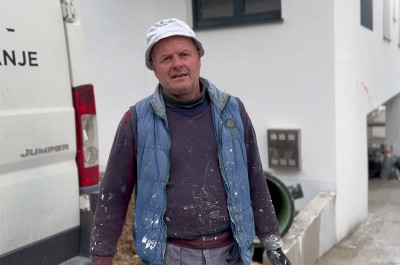The Croatian real estate market in 2025 continues to record an upward trend, with increasing prices of residential properties, particularly in urban and coastal areas. Young people, however, are finding it increasingly difficult to secure their own homes, and the question of how rising prices will affect the rental market is becoming ever more significant. What is the current state of the real estate market? We analyze the latest statistics, along with the advantages and challenges ahead, especially for young people and the rental market.
- Price Trends: How Much Does an Apartment Cost in Croatia?
According to the latest data from the Croatian Bureau of Statistics (DZS) from April 2025, the prices of residential properties in Croatia rose by 10.1% in the fourth quarter of 2024 compared to the same period the previous year. Although the growth has slightly slowed, the upward price trend persists.
- Comparison with the Previous Quarter: Prices increased by 1.4%, indicating that the market continues to grow, albeit at a slower pace.
- Long-Term Trend: Since 2017, the Croatian real estate market has recorded an average annual price increase of 8–12%. This long-term trend points to steady but potentially unsustainable growth, driven by several factors: increased demand, inflation, rising construction costs, and the presence of foreign investors.
Regional Price Differences
- Adriatic Coast: In 2024, residential property prices rose by 16%, marking the highest recorded increase. On the coast, especially in tourist areas like Split and Dubrovnik, prices are elevated due to heightened demand.
- Zagreb: The capital saw a more moderate increase of 7.7%, reflecting market stability but still relatively high prices, with average prices for new apartments in Zagreb ranging from €2800-3500/m².
How Apartment Prices Affect the Market
- New Builds vs. Older Apartments: Interestingly, older apartments are experiencing a higher price increase (up to 15% annually) due to the limited supply of new builds. This creates additional pressure on young people seeking cheaper options, yet the rising prices of older properties still make them unaffordable.
- Factors Driving Price Growth: Increased tourism demand, an influx of foreign buyers (especially from Germany and Austria), inflation, and rising construction costs contribute to the continuous price surge, making Croatia one of the fastest-growing markets in the EU.
- Impact on Young People: The Dream of Homeownership Slipping Away
For young people in Croatia, particularly those aged 25 to 35, the rising cost of real estate poses a serious barrier to purchasing their own homes.
Financial Barriers for Young People
- The average net salary in Croatia at the end of 2024 was around €1200, while the price of a 60 m² apartment in Zagreb reached €180,000. Considering that banks approve housing loans up to 30-35% of monthly income, young people would need to work for nearly 20 years to cover the cost of an apartment, excluding other living expenses.
Credit Accessibility:
- Interest Rates on Housing Loans: In 2025, interest rates on housing loans in Croatia rose to 3.5-4%, meaning the monthly payment for a €150,000 loan would be €800-900. For many young couples and individuals with a single income, this is simply unattainable.
- Economic Independence and Stress: A significant number of young people continue to live with their parents because they cannot afford their own homes. 45% of young people up to age 34 live with their parents (2024 statistics), highlighting growing challenges in achieving independence. Moreover, the rise in prices continues to outpace wage growth, increasing uncertainty among the youth.
- National Housing Policy Plan: A Potential Solution or Mere Illusion?
In response to this situation, the Croatian government adopted the National Housing Policy Plan until 2030 at the end of March 2025. The plan includes measures aimed at helping young people access the housing market.
Measures in the National Housing Policy Plan:
- Financial Support for Young People: Planned subsidies for first-time buyers and more favorable housing loans for young families could ease entry into the market.
- Tax Reform: Taxes on vacation homes and stricter regulation of rental income aim to reduce the dominance of short-term rentals (Airbnb), thereby increasing the availability of apartments for long-term rent.
- Incentives for Construction: Government measures include encouraging the construction of affordable housing, which could increase the supply of apartments and reduce pressure on prices.
According to Experts:
Experts remain cautious about the effectiveness of these measures. Matej Samardžić, a real estate agent, believes that the limited supply of apartments remains a key issue that won’t be easily resolved, and the measures may not have an immediate impact on price reduction.
- Rental Prices: Will They Rise or Fall?
Rental prices continue to follow the trends of residential property prices, but their impact on the rental market varies. In 2024, rents rose in line with property price increases, especially in coastal cities.
Rental Prices by Region:
- Split and the Coast: In coastal areas, where tourism is a significant market factor, rents have seen substantial growth. For instance, the average rent for a 50 m² apartment in Split was €800-1000. In Zagreb, average rental prices were slightly lower, ranging from €600-800.
- Zagreb Scenario: With less influence from tourism, rental prices in Zagreb are more stable but still under pressure from rising property costs.
Impact of New Government Regulations on the Rental Market:
New government measures aimed at restricting short-term rentals (such as Airbnb) could increase the supply of long-term rentals, potentially reducing rental prices in coastal areas by 5-10%.
- What Does This Mean for the Future of Real Estate and Rentals?
The Croatian real estate market continues to grow, but prices are rising faster than wages, creating increasing challenges, particularly for young people.
For Young People:
If prices continue to outpace wages, Croatia could face a demographic crisis as young people struggle to start families or become independent.
For the Rental Market:
Rental prices could stabilize or even decrease, particularly in coastal cities, if government measures genuinely improve the supply of long-term rentals.

 Croatia
Croatia Bosnia and Herzegovina
Bosnia and Herzegovina Serbia
Serbia Crna Gora
Crna Gora North Macedonia
North Macedonia Ukraine
Ukraine Albania
Albania Kosovo
Kosovo Austria
Austria Deutschland
Deutschland Switzerland
Switzerland









